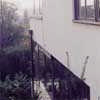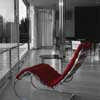Tugendhat Villa Brno architect, Mies van der Rohe building design, Modern Czech House furniture
Tugendhat Villa Brno House
Mies van der Rohe House in the Czech Republic – Modernist Home
post updated 20 April 2025
Location: Brno, Czech Republic
Date built: 1930
Architect: Mies van der Rohe ; renovation architect: AMOSDESIGN
Interior realized by AMOSDESIGN
Villa Tugendhat Interior Renovation
21 Mar 2012
Tugendhat Villa Renovation
Furniture restoration in the Villa Tugendhat, originally designed by Mies van der Rohe, was aimed at restoring some of the remaining interior doors and reproduction of the original wooden built-in and freely positioned furniture, including metal furniture.
Regarding restoration and manufacturing of wooden furniture, we have explored all available resources such as period photographs, project documentation in museums (such as MOMA), literature and contacts with the families of the original owner and architect. We also visited numerous buildings designed by Mies van der Rohe in Europe and the USA.
From this comprehensive survey, we have prepared a rather extensive documentation which served as a basis for subsequent manufacturing. We had to make replicas of locks, hinges and parts for assembling of cupboards, tables or cabinets. We used only original materials such as wood panels, plywood and veneers. We have never used contemporary standard sheet materials, but rather historical connecting materials, including bolts and screws.
We have adjusted details to our latest knowledge until the very last moments. We have used such rare materials as 100% zinc plate, solid steel, chrome, flexible tubular steel, brass, hand-tanned leather, parchment, opaque glass, black glass, crystal glass, rubber and leather straps, green marble, a number of textile covers, many wooden materials as well as European and tropical veneers.
As a final finish for maple, rosewood, pear, beech, oak, zebrawood and macassar veneers we used synthetic oil with alkyd resins, determined by research as the contemporary coating material. It was specially made for the renovation according to original recipes.
For the upholstery of sofas, beds and other interior parts we used only original materials such as jute, horsehair, African grass and traditional metal springs. All special works were carried out either by qualified renovators or under their supervision. The upholstery was often made from materials that are either unusual or no more used. We also found out that the professions needed for the realization of the interior are no more available.
It was necessary to equip the villa with metal replicas of the original furniture that had to be made individually.
Returning of the round macassar dining wall to the villa turned out to be crucial. The wall disappeared from the building in 1940 and was considered to be completely lost. Art historian Miroslav Ambroz announced the discovery of the wall in a busy university canteen in Brno in 2010, where it served as a wall cladding for 70 years.
The panels were removed in 2011, restored, new sections were added and the wall was returned to the villa. This is one of the most interesting stories of the restoration. Thousands of people have watched the panels for years while nobody realized the context. The returning of the wall to its original place was an emotional experience even for the TUGENDHAT family.
Metal furniture in the Villa Tugendhat by Mies van der Rohe
Renovated metal furniture in the original 1930s versions is now placed in the villa. Such furniture is not available on the market anymore.
Given the fact that many chairs and tables were created in the year when the villa was built or designed specifically for the villa, many were prototypes modified for various reasons in the years before World War II. The reasons were usually structural and practical (lack of experience with new designs). The furniture had not been tested and it was thus impossible to determine its real-life properties and durability in advance.
After World War II, the simplifications and modifications continued. Technological, material, dimensional and assembly modifications meant that many products changed substantially compared to their 1930 versions. KNOLL USA began to produce the furniture in the 1950s and subsequent decades using completely new drawings supplied by the Mies van der Rohe studio and their own designs, using for example new, non-metric cross-sections for steel. New developments and changes are still taking place.
Some metal furniture in the villa was not even designed by Mies or he did not design it by himself. For example, the MR chairs were made, with the family and the co-author Lilly Reich´s consent, by TECTA, while the serving trolley was originally made by Thonet (discontinued a long time ago). The influence of the assistant designer Sergio Ruegenberg on the subsequent appearance of the furniture has not yet been significantly determined.
Entirely new manufacturing drawings for the existing original chairs were prepared for the villa restoration, with references to Mies’ original documentation, and the procedure was approved by the contracting authority, designers and THICOM.
A significant part of the original metal furniture (Barcelona, ottoman, Brno flat chair, Dessau table, chaise lounge, table MR) is owned by the Brno Municipal Museum, the Tugendhat family and the Mies family.
This is where we searched for relevant information. The new museum replicas are clearly distinguishable from contemporary production. Existing pieces were studied in the USA, Germany, Austria and the Czech Republic – these were basically all existing or related pieces of furniture from the villa. The furniture was physically measured, drawn, original general drawings were traced and the furniture was X-rayed thoroughly. These were truly detailed 1:1 drawings, while the detailed research materials and unique comparative drawings compared the current and the original production of metal furniture.
Tugendhat Villa plans

photos from architects
As a result, the furniture in the villa is not a poor copy of the contemporary furniture by Mies van der Rohe, but rather furniture in its original appearance, and we could even say, with a slight exaggeration, that these replicas are the only existing original furniture. And like the Barcelona chair, many are museum replicas of chairs owned by the same entity that operates the Villa Tugendhat.
The result of the Tugendhat Villa restoration is a condition of the interior which is as close as possible to its 1930 appearance, while the attention to detail is unique among renovations of the 20th century architecture. The visitors can thus travel back in time to 1930 when the villa was completed.
Mies van der Rohe

photo from architects
Tugendhat Villa Renovation information from AMOSDESIGN
Vila Tugendhat
New photographs of Villa Tugendhat added – 27 Mar 2012:
Villa Tugendhat
On 6th March last, Villa Tugendhat reopened to the public after its closure and a complete two-year refurbishment program which included full restoration of its interior and furnishings. I was lucky enough to visit just before its closure for said renovation in September 2005, but more of that later.
Preceding the opening to the public was the ceremonial opening which took place on 29th February. Given Tugendhats status in the canon of architectural works and its UNESCO listed status it was to be expected that the opening would attract major heads and representatives.
A press conference was attended by Brno City Mayor, Roman Onderka, Deputy Mayor Robert Kotzian, daughters of the Tugendhats, Daniela Hammer-Tugendhat and Ruth Guggenheim-Tugendhat.
It was fitting, given the cultural and artistic openness of the Tugendhats in firstly commissioning Mies and secondly living the modernist dream so fully that a musical performance was given by the legendary Brno jazz musician Jaromir Hnilicka. What would Grete’s mother have thought!
A newly extended guided tour is offered which includes the technical floor of the house and a newly installed exhibition in the basement informing visitors about its architect, Mies van der Rohe, the villa, the owners and their lives there until their departure in 1938 due to the second World War. There is also (of course) the ubiquitous book and souvenir shop in the basement where visitors can purchase publications on villa Tugendhat and Brno architecture of 19th and 20th centuries.
Fritz and Grete Tugendhat first met Mies van der Rohe in Berlin in the summer of 1928 and during that summer Mies visited the site which was originally belonging to a house in Sadova Street owned by Alfred Low-Beer, Grete’s father. On 22 April 1929 an application for planning permission was submitted and in June of that same year construction began.
Tugendhat Villa
Location: Brno, Czech Republic
Date built: 1930
Architect: Mies van der Rohe
Brno building – scanned photos from 1996, by architect adrian welch
Entry (east) front at higher level:
The Tugendhat Villa is one of the most famous Modern houses of the 20th century, this building expresses the same pure, bold aesthetic as the Barcelona Pavilion, but here the building is designed to be lived in.
Photography is prohibited inside the Tugendhat Villa hence the exterior photos above.
View from garden looking northeast to Tugendhat Villa:

An intriguing feature of the Tugendhat Villa are the living space windows which electrically recess into the wall below – genius!
Tugendhat Villa architect : Mies van der Rohe
Views looking west past house:




Whilst working for Eva Jiricna Architects a group of us visited the office’s work in Brno – the Lavka Bridge – and to see one of Mies van der Rohe’s best houses, the Tugendhat Villa. Classic pictures don’t make this celebrated Modern house look seductive but the building has the power of the Barcelona Pavilion, except it was built for a family, for domesticity.
The simple red onyx wall designed to glow crimson with the sunset, peppered by opaque stones and small holes, is a tour de force as are the radical full-height windows that dropped into the floor to engage ‘house’ and ‘garden’. One of the best houses I’ve visited. Adrian Welch, Architect
Address: Černopolní 237/45, 613 00 Brno-sever, Czech Republic
Phone: 545 212 118
Location: Černopolní 237/45, 613 00 Brno, Czech Republic, Europe
Architecture Design
Contemporary Building Designs – recent architectural selection from e-architect below:
Brno bridge – Lavka bridge project by Eva Jiricna Architects (Project Architect was Adrian Welch, editor of this website)
More Czech architecture : Prague building
Mies van der Rohe architecture : Barcelona Pavilion

photo © Adrian Welch
Tugendhat Villa, Mies van der Rohe : Photos © Adrian Welch
Comments / photos for the Tugendhat Villa Brno design by Mies van der Rohe architect – modern Czech house page welcome.
Website: www.tugendhat.eu

























